Stormwater Management
Stormwater runoff is created when rain falls on pavement, buildings, and other impervious surfaces that do not allow water to soak into the ground. In developed areas like Lansing, we limit flooding by moving this runoff from our buildings, parking lots, and neighborhoods through storm drains, many of which discharge directly into rivers and streams. Because water in our storm sewer does not get processed at a treatment plant, any contaminant on the ground can "hitch a ride" with runoff and impact our shared surface waters. Pet waste, oil, leaves and dirty water from cleaning your car can enter storm drains and flow downstream where it harms aquatic habitats and makes water unsafe for swimming, canoeing and other water-related activities. The School District takes steps to reduce this pollution from our facilities to improve water quality and to meet State and Federal requirements.
Per these requirements, the District must apply for a stormwater discharge permit every five years. A large part of that application consists of a description as to how the District will commit to and proceed with the development, implementation, and enforcement of practices to reduce the discharge of pollutants from its municipal separate storm sewer system to the maximum extent practicable. This documentation was formally designated as Lansing School District’s Stormwater Management Program, which is located below for public review and input.
![]() Stormwater Management Program Plan Requirements
Stormwater Management Program Plan Requirements
![]() MS4 Progress Report Jan 2014 to April 2016
MS4 Progress Report Jan 2014 to April 2016
To help facilitate a regional approach to stormwater management, the District is also a member of the Greater Lansing Regional Committee for Stormwater Management, a guiding body comprised of Municipal Separate Storm Sewer System (MS4) communities within the Greater Lansing Region. The committee has been established to guide the implementation of the stormwater program for participating communities within the Grand River, the Red Cedar River and the Looking Glass River watersheds. Visit MyWatersheds.org to learn about upcoming events, find steps you can take to limit water pollution, and to get involved in managing our shared water resources!
The Basics of Stormwater
What is Stormwater?
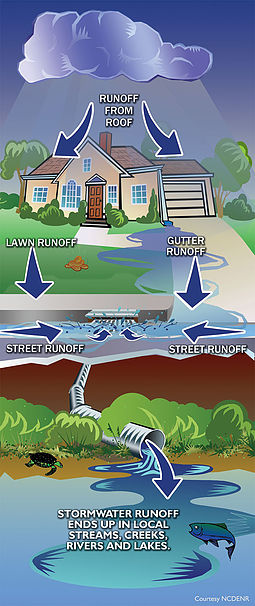 • When it rains, water lands on grass, trees, roads and sidewalks
• When it rains, water lands on grass, trees, roads and sidewalks
• When it reaches the grass, the rain soaks into the ground, but when it hits the sidewalks, roads and other impervious materials, the rain runs off these surfaces and becomes stormwater
• Stormwater runs down the street and into storm drains. In areas with Municipal Separate Storm Sewer Systems, the storm water flows directly into rivers, lakes and streams (learn more about MS4s)
• Along the way it picks up pollutants that impact water quality and aquatic habitat
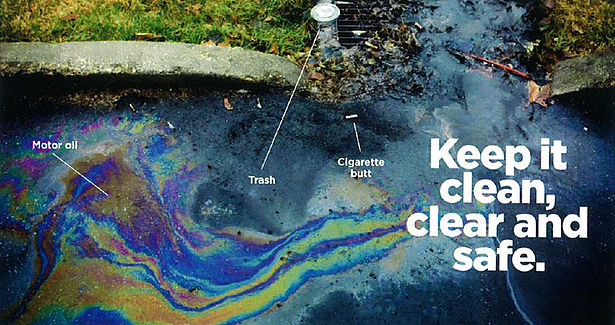
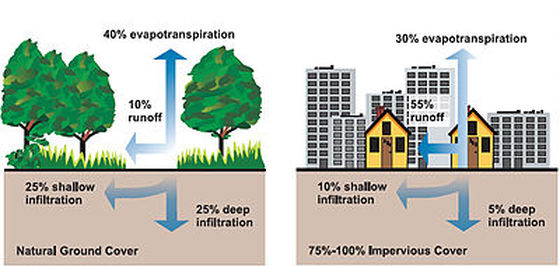
The Different Types of Stormwater Sewers
Storm/Sanitary & MS4/CSO
It's easy to get confused.
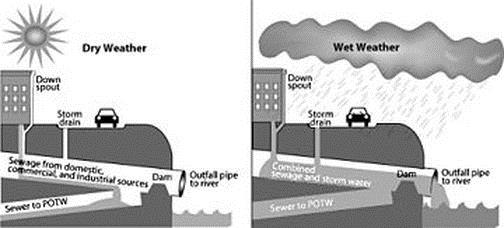
(Combined Sewer Overflow "one pipe system")
You wouldn't be alone in thinking that communities have one sewer system, but there are typically two: a storm and a sanitary sewer.
Storm sewers redirect runoff formed during rain or snow events into a system of catch basins and pipes.
Sanitary sewers collect the wastewater from toilets and taps. This water is sent to a treatment plant to be cleaned.
Here's where things get more tricky: there are also two types of storm sewers. Combined Sewer Overflows, or CSOs, are older systems but still remain in use in some areas. This "one pipe system" combines both surface runoff (stormwater) with wastewater (sewage) and leads to a treatment plant for processing. However, as the illustration shows, these systems were designed to overflow when a heavy rain or snow melt event backlogged the system. When this occurs, the mixture of stormwater and raw sewage would flow directly into a river, stream or lake.
Untreated sewage entering our surface water had obvious impacts to the water quality and ecosystems that depend on these habitats.
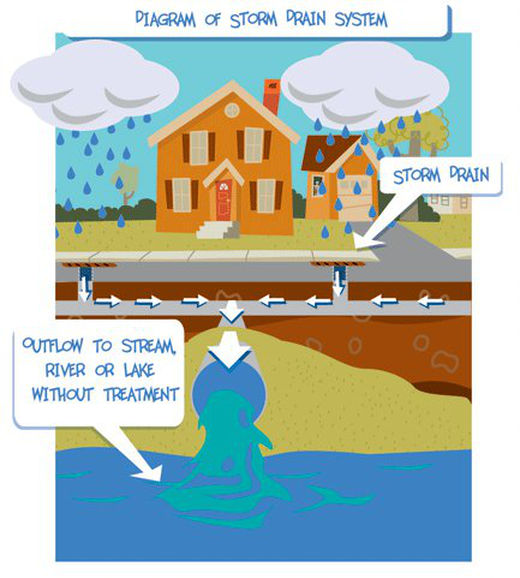 To combat this, modern storm sewers have moved away from the "one pipe system" of the past and separate wastewater from storm runoff. Most of the storm sewers in the Greater Lansing area are what we call Municipal Separate Storm Sewer Systems (MS4s). Here, the sanitary sewer still directs sewage to the treatment facility, but stormwater is diverted directly to water bodies.
To combat this, modern storm sewers have moved away from the "one pipe system" of the past and separate wastewater from storm runoff. Most of the storm sewers in the Greater Lansing area are what we call Municipal Separate Storm Sewer Systems (MS4s). Here, the sanitary sewer still directs sewage to the treatment facility, but stormwater is diverted directly to water bodies.
The MS4 system reduces the risk of large quantities of sewage entering the surface water, but since stormwater doesn't go to the treatment plant, it has it's own risks and must be "treated" in other ways. As illustrated in the graphic to the right, MS4s rely on catch basins and built infrastructure to filter out large pieces of litter, sediment, and oils, but these systems only work if they are cleaned, maintained, and understood by the public. If you see someone pouring anything down a storm drain, report it! Also report clogged or dirty catch basins to your municipality.
By reducing runoff, picking up after your pet, and keeping illicit discharge out of the drains, you can keep it out of the watershed.
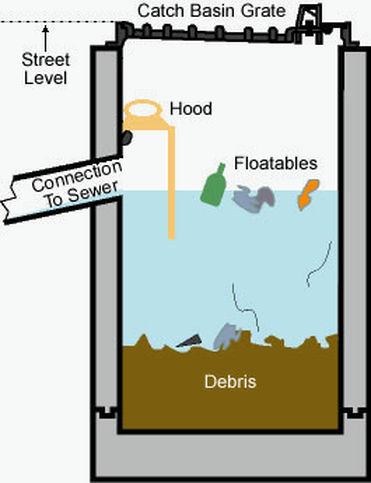
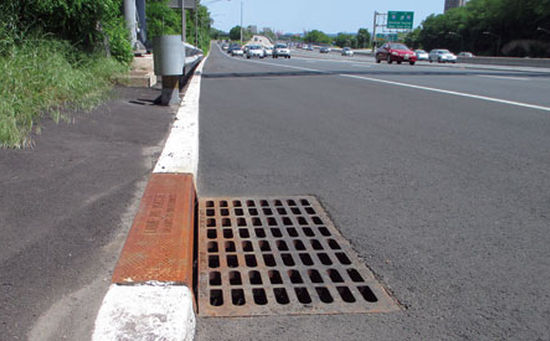
Your Role in Water Protection
How can you help keep our waters clean?
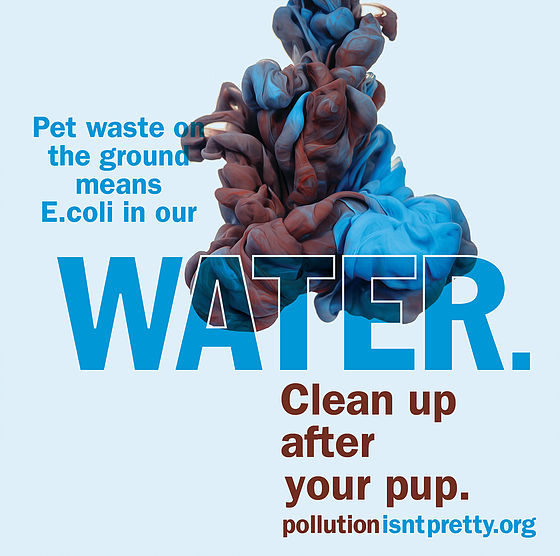 PICK UP AFTER YOUR PET - stormwater transfers E. Coli from pet waste into surface water. Keep canoeing and swimming safe by properly disposing of pet waste.
PICK UP AFTER YOUR PET - stormwater transfers E. Coli from pet waste into surface water. Keep canoeing and swimming safe by properly disposing of pet waste.
PASS THE SALT - driveway salt can increase chloride levels in surface waters and become toxic to wildlife at high levels. Use sparingly, or find a more safe alternative.
HEAD TO THE CAR WASH - washing your car in the driveway can send grease, oils, fuel, soap and dirt into storm drains and into rivers. Car wash facilities have special drains and dirty wash water is treated.
RAKE YOUR YARD - excess leaves can clog street drains. This can cause flooding, and decaying plants also rob surface water of oxygen, harming aquatic life.
GARDEN SAFE - lawn pesticides harm aquatic life, and fertilizers can cause algae to overgrow and destroy river habitats. Limit usage or use environmentally friendly alternatives when possible.
USE A RAIN BARREL - the more water you keep from the drains, the better. Attach a rain barrel to your gutter system and use it to water your plants.
CLEAN YOUR SEPTIC - keep your septic system well maintained. Septic systems can leach E. Coli into the watershed.
REPORT POLLUTERS - if you see someone illegally dumping into storm drains, know what to do! Alert your municipality of illegal activity.
See what residents and agencies are doing to help!
Want to learn more about how you can protect our waterways at your home, school, or business? Check out these articles, brochures, and flyers and feel free to print and post them at your workplace or classroom!
![]() Educational Articles
Educational Articles
![]() GLRC Brochures
GLRC Brochures
![]() Business and Construction Stormwater Flyers
Business and Construction Stormwater Flyers
The Six Minimum Measures
MS4: The Six Minimum Measures
The Environmental Protection Agency's Stormwater Phase II Rule establishes an MS4 stormwater management program that is intended to improve the nation's waterways by reducing the quantity of pollutants that stormwater carries into storm sewer systems during rain events. The GLRC began meeting in 1998 and was formed under a Memorandum of Agreement in 2004. The GLRC has been established to guide the implementation of the MS4 program for participating communities within the Grand, Red Cedar, and Looking Glass River watersheds.
The six MS4 program elements, termed "minimum control measures", that drive the efforts of the GLRC are described below:
Construction Site Runoff Control:
Developing, implementing, and enforcing an erosion and sediment control program for construction activities that disturb one or more acres of land. Controls could include silt fences and temporary stormwater detention ponds.
Post-Construction Runoff Control:
Developing, implementing, and enforcing a program to address discharges of post-construction stormwater runoff from new development and redevelopment areas. Applicable controls could include preventative actions such as protecting sensitive areas (e.g., wetlands) or the use of structural BMPs such as grassed swales or porous pavement.
Pollution Prevention/Good Housekeeping:
Developing and implementing a program with the goal of preventing or reducing pollutant runoff from municipal operations. The program must include municipal staff training on pollution prevention measures and techniques, such as regular street sweeping, reduction in the use of pesticides or street salt, or frequent catch-basin cleaning.
Public Education and Outreach:
Distributing educational materials and performing outreach to inform citizens about the impacts polluted stormwater runoff discharges can have on water quality.
Public Participation/Involvement:
Providing opportunities for citizens to participate in program development and implementation, including effectively publicizing public hearings and/or encouraging citizen representatives on a stormwater management panel.
Illicit Discharge Detection and Elimination:
Developing and implementing a plan to detect and eliminate illicit discharges to the storm sewer system. Activities include developing a system map and informing the community about hazards associated with illegal discharges and improper disposal of waste.
MyWatersheds.org
The Greater Lansing Regional Committee for Stormwater Management (GLRC) is a guiding body comprised of Municipal Separate Storm Sewer System (MS4) communities within the Greater Lansing Region. The committee has been established to guide the implementation of the stormwater program for participating communities within the Grand River, the Red Cedar River and the Looking Glass River watersheds. For more information related to the mandated stormwater program, visit the Michigan Department of Environmental Quality website.
Please call (517-393-0342) or email GLRC Coordinator Cliff Walls at cwalls@mitcrpc.org at the Tri-County Regional Planning Commission if you have questions or need immediate assistance.
The GLRC also publishes Quarterly and Annual Newsletters.
For Homeowners
The GLRC has developed a variety of public education materials for homeowners and interested individuals to view here. Please take some time to look at the GLRC materials on the GLRC Residents website and learn about watershed management and how you and your community can help reduce pollution in our local waterways. Local clean-up and recycling events can also be found here.
We are part of the effort to keep our water clean; you can learn more about your water quality and our Pollution Isn't Pretty campaign by visiting the Pollution Isn't Pretty website.
Please help us protect the Grand River Watershed by reporting illicit discharges, connections, and dumping into the storm sewer system. If you happen to see something entering or exiting a storm pipe, catch basin, or drainage ditch that looks, smells or feels like something other than storm water, please contact:
Operations Department
517-755-3014
Facilities@lansingschools.net
You can also report polluters through the Michigan Department of Environmental Quality’s Pollution Emergency Alerting System (PEAS) hotline at 800-292-4706.


